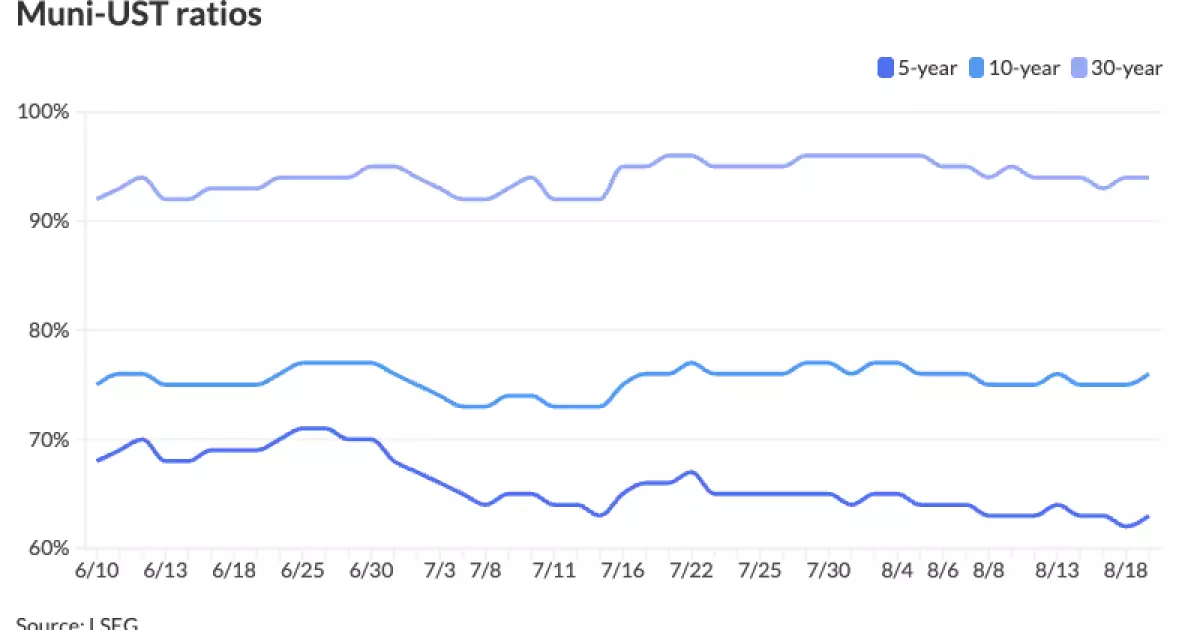The recent fluctuations in the municipal bond market have once again illuminated its fragile underpinnings. Despite headlines touting resilience amidst rising Treasury yields, beneath the surface lies a critical tension. The market’s strength, often hailed as a sign of fiscal robustness, masks underlying vulnerabilities that could spell trouble if economic conditions shift suddenly. While analysts paint a picture of stability buoyed by Treasury market strength and favorable reinvestment flows, this narrative overlooks the precariousness wrought by rising interest rates, thin demand, and looming supply pressures. The assertion that municipal bonds remain “strong” borders on complacency—an optimistic charade that may not withstand the severe headwinds on the horizon.
Supply and Demand: A Volatile Dance on the Edge
August’s reinvestment flows of roughly $55 billion momentarily bolstered the market; however, these are merely temporary prop-ups in a landscape marked by excess supply and diminishing retail momentum. The market’s capacity to absorb continued issuance at elevated levels—projected to reach over $600 billion this year—is questionable at best. The recent slowdown in non-exchange-traded fund flows, driven by inflation concerns and economic uncertainty, signals a shift that could undermine the market’s liquidity. Despite robust institutional demand, especially from separately managed accounts, the retail appetite remains tepid, and the market’s thin crossover demand could prove insufficient during less favorable economic periods.
Interest Rates and the Yield Curve: A Recipe for Instability
While the yieldcurve steepening has not yet translated into wider credit spreads, history suggests this is a harbinger of potential stress. Steep curves often indicate market anxiety about long-term creditworthiness, especially when accompanied by widening spreads in high-yield sectors. The imminent pause or slowdown in Federal Reserve rate cuts in 2025 will likely tighten pre-Fed front-end demand, further complicating the municipal landscape. The market’s perceived “cheapness,” rooted in a steep curve, could ironically serve as a warning sign of looming correction. Investors’ overreliance on these signals, without considering underlying credit deterioration, is a dangerous game.
High-Yield Woes and the Impact of External Events
The Brightline incident and hurricanes during the Atlantic season, though not catastrophic now, underscore the vulnerabilities in lower-rated municipal bonds. High-yield indices are more sensitive to such shocks, and the potential for contagion remains if stress in these sectors spreads. The market’s supposed resilience, especially in higher-rated sectors, is misplaced if external shocks become more frequent or severe. The complex web of risks—including economic downturns, natural disasters, and political scandals—are not adequately priced into current valuations, setting the stage for sudden and sharp declines should tensions escalate.
The Illusion of Safety in “Safe” Sectors
Though safe sectors have seen minimal credit deterioration, this state of affairs is largely due to heightened scrutiny, conservative underwriting, and market discipline. However, the complacency fostered by these cushion periods could backfire if macroeconomic conditions worsen or credit quality is hidden behind structural defenses. The assumption that safe sectors will always withstand shocks is flawed; history shows that crises often reveal weaknesses previously ignored or underestimated. The current stability might be a façade that crumbles under the weight of an unexpected economic or geopolitical shock.
Market Dynamics and Policy Uncertainty
Upcoming Federal Reserve signals and policy data releases are set to influence market direction significantly. The expectation of fewer or delayed rate cuts in 2025 could dampen the demand from pre-Fed investors, nudging yields upward. Conversely, continued strong demand from long-term income-seeking retail investors, particularly in mountainous SMA portfolios, could support prices, but only temporarily. The risk is that these demand channels are predicated on investor optimism rather than fundamental safety, leading to a false sense of confidence that may evaporate when market sentiment shifts.
Structural Risks Ignored in the Current Narrative
What remains largely unaddressed in mainstream analysis is the structural vulnerability of the municipal market—its dependence on memory of past stability, the artificial boost from reinvestment flows, and the thin margins of demand. When interest rates rise sharply or economic growth stutters, these elements could combine to produce a perfect storm. Investors should be wary of extrapolating recent stability into the future. The current market environment is a delicate equilibrium, and history warns that complacency can be quickly replaced by crisis.
The Bottom Line: An Already Wounded Market Waiting for a Spark
No matter what the latest stats or official commentary suggests, the municipal bond market’s veneer of strength hides more than it reveals. Elevated issuance, falling reinvestment flows, external shocks, and a potentially changing monetary policy landscape collectively threaten the fragile balance. What appears to be resilient today could quickly morph into vulnerability when economic tides turn or unforeseen events strike. Skepticism, not complacency, should guide investors and policymakers alike—because beneath the surface, the municipal market’s structural fragility may be closer to a breaking point than most realize.

